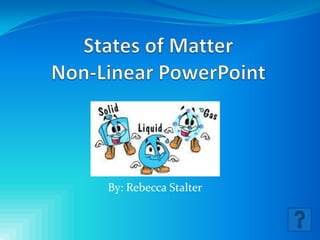
Ed nonlinear pp
- 2. Subject – Sixth Grade Science Title of Lesson - States of Matter Objective - To teach students how to identify the different states of matter. Objective 1: Students should be able to identify the 3 different states of matter Objective 2: Students should be able to distinguish between the 3 different states of matter. Objective 3: Students should be able to list a physical property of each state of matter. Objective 4: Students should be able to explain and draw the difference of the space between particles in the 3 different states of matter. Objective 5: Students will be able to list examples of each state of matter in our daily life.
- 3. Procedures – Students will move in groups to 6 stations guessing what state of matter the materials at that station are. Students will regroup as a whole. We will discuss our observations in groups and come to conclusions about each state of matter while going through the PowerPoint. Evaluation - The Quiz Materials – Pen, paper, PowerPoint, 2 object examples of gas, 2 of liquid, 2 of solid.
- 4. Standards Physical Sciences Benchmark A: Relate uses, properties and chemical processes to the behavior and/or arrangement of the small particles that compose matter. Nature of Matter 3. Describe that in a physical change the chemical properties of a substance remain unchanged. 4. Describe that chemical and physical changes occur all around us. Scientific Inquiry Benchmark C: Give examples of how thinking scientifically is helpful in daily life. Science and Society 4. Identify ways scientific thinking is helpful in a variety of everyday settings.
- 5. What is matter? Matter is defined as anything that has mass and takes up space. Matter can take the form of a solid, a liquid or a gas.
- 6. What is matter made of? All matter is full of tiny little particles called atoms. The way the atoms are packed and how the atoms move together determine which state the object is, solid liquid or gas.
- 7. Properties of a Solid Solids have a fixed volume and shape. Solids are not easily compactable. Particles are tightly packed with little room to move. Examples of Solids: Crayons, Slides, Doors, Sponges Can you think of some examples?
- 8. Properties of a Liquid Liquids assume the shape of their container. Liquids have a fixed volume. Liquids are not easily compressible. Examples of Liquids, Water, hand soap. Particles are farther apart Can you think with some room to slip and of some examples? slide past each other.
- 9. Properties of a Gas Gases assume the shape and volume of their container. Gases are easily compressible. Particles are far apart and fast moving. An example of a gas is helium in a balloon. Can you think of any examples of a gas?
- 10. Matter is all around us…
- 11. Here is a song to help us remember our states of matter.
- 12. Resources: Newman, D. (2011, February 5). The matter song. Retrieved from http://www.youtube.com/watch?v=Bn3v_LUVIOI States of matter. (2009, January). Retrieved from http://www.chem.purdue.edu/gchelp/atoms/states.ht ml States of matter. (1999). Retrieved from http://www.edinformatics.com/math_science/states_ of_matter.htm
- 13. Use Your Brain! Answer these questions in order Question 1 Question 2 Question 3
- 14. Question 1 What is the definition of matter? Anything you can see. Any that has mass and takes up space. Anything that has weight.
- 15. Question 2 Which state of matter has loosely packed particles that move fast and freely past each other? Solid Gas Liquid
- 16. Question 3 Which of these are the physical properties of a liquid? No definite shape or volume, compressible, particles loosely packed. Definite shape and volume, not compressible, particles tightly packed. Definite volume, no definite shape, not compressible, particles are packed together
- 17. Great Job!! The correct definition for matter is anything that has mass and takes up space. Question 2
- 18. Try Again Please review the following information and try Question 1 again.
- 19. Great Job!! Gases have loosely packed particles that are free to move and slide past each other. Liquids are particles are packed tighter together with some room to move but not much. Solids are tightly packed with no room to move past each other. Question 3
- 20. Try Again Please review the following information and try Question 2 again.
- 21. Great Job!! A liquid has a definite volume, no definite shape, not compressible, particles are packed together with some room to move. A gas has no definite shape or volume, compressible, particles loosely packed. A solid has a definite shape and volume, not compressible, particles tightly packed.
- 22. Try Again Please review the following information and try Question 3 again.